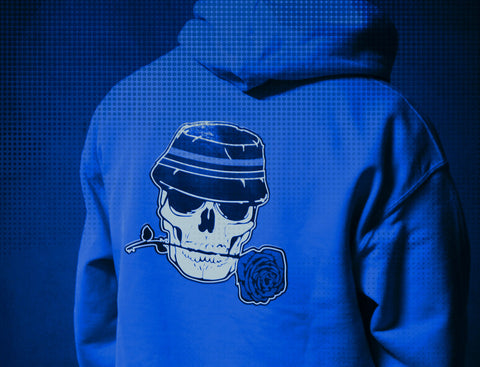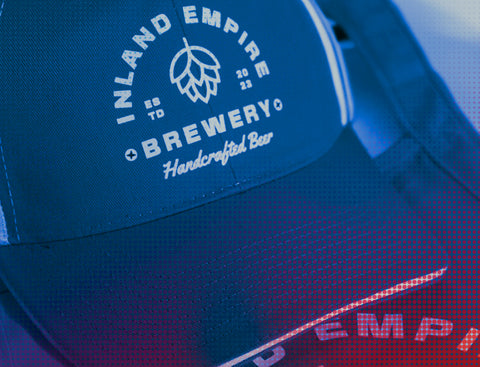The custom apparel market is booming and is expected to grow at a CAGR of 7.22% from 2022 to 2027. Hoodies are a wardrobe staple and are the perfect transition to fall and winter wear - as well as an all year round option if you choose a more lightweight material.
Whether you’re a business looking to create your team’s seasonal apparel or you’re a side hustle looking to sell your own designed hoodies, actually knowing how to make custom hoodies is the hardest step. With so many resources and so much information about different techniques and different types of apparel out there, we’ve decided to give you a helping hand and collate all of the most important steps and considerations that you need to take in order to create your very own custom hoodies with your logo, design or message.
Buckle in as we show you how to make custom hoodies quickly and easily right here at DTF Transfers.
Table Of Contents
- Planning Your Custom Hoodie Project
- Preparing Your Workspace
- Printing Methods For Custom Hoodies
- Post-Production Steps
- Conclusion
Planning Your Custom Hoodie Project
Defining Your Niche
When planning your custom hoodie project, it’s important to have clear direction on who you’re targeting and how you’re going to do it. Defining your niche is imperative to this, giving you a clear vision for your hoodies.
For businesses creating team apparel, this is a little easier to define. You simply need to add your logo to a variety of sizes of hoodies.
For side hustles looking to create a new range, this is a little more difficult as you’ll likely want to have specific sizes and fits for your general target audience. For example, if you’re targeting men you will want different styles to if you were targeting primarily women or kids.
Design
The same goes for the design of your custom hoodies. Having a clear vision for who it is that you’re trying to target with your hoodies can help to make having appropriate designs easier. This will also depend on the print method that you choose - which we will cover later - as some printing methods allow for more intricate designs than others.
Consider Creative Trends
Consider creative trends and ideas when identifying your designs to really attract your audience. Scour the internet and social media channels like TikTok, YouTube and Instagram to get a clear idea of what your audience are looking for.
As an example - if you’re selling band t-shirts, is the distressed look still in style or is a more tie-dye colorful approach a better option? See what your target audience are already wearing, compare against what your main competitor sites are offering and you can find the most appropriate styles for you. Don’t forget - you want to create designs that are going to help you to stand out from the crowd.
Sourcing Quality Hoodies
There are three main qualities to look for when choosing a type of hoodie -
Softness Durability WarmThese qualities tend to come from the hoodie’s fabric, composition and weight, so it’s important to scour different brands and types of hoodies to find the right fit for the apparel you’re looking to create.
Remember, the quality of your hoodies will be a reflection of your brand. If the product you are selling with hour designs is low quality - it starts to fall apart after one wash for example, then people are less likely to recommend your brand or come back to purchase from you again.
Sizing & Fit
Understanding the sizing and fits that you will require is also important. By fit, we’re looking at slim-fit, standard fit, oversized etc.
For sizing, it has a good distribution between all sizes particularly if you’re unsure what you’re likely going to need. Our experts recommend the following distribution of sizes for bulk and group orders:
- XS - 1%
- S - 10%
- M - 23%
- L - 31%
- XL - 23%
- 2XL - 9%
- 3XL - 3%
Preparing Your Workspace
Preparing your workspace properly is vital to ensuring you have a quick and efficient process.
This is particularly important if you’re pressing your transfers yourself. Specific preparation instructions vary depending on the printing method that you are going to use - more on this below. If you’re opting for DTF transfers when creating your next batch of custom hoodies, learn how to press them.
Start by having a clean and clear workspace, that is clutter free and remove any items that could be potentially distracting or damaged during the printing process.
Cover your work surface prior to putting your equipment in place to ensure any potential spills (whether this is inks or chemicals) do not damage this. This can also make the clean up process easier and protect from spills.
Some printing methods involve the use of strong chemicals, so ensure you have plenty of ventilation in place. Make sure to also have any protective equipment such as gloves and masks if you are using dangerous materials.
Have bright, natural lighting (or add extra lighting if needed depending on the location of your workspace) to ensure you can see your work and equipment clearly.
Gather all of the supplies that you need for the entire process, and ensure that they are within easy reach and organized to speed up the printing production times. Some examples of supplies that you may need include the blank hoodies, printing screens, inks, squeegees, stencils, transfers, any tools that you may require. This will help to minimize disruption during the production. The supplies and equipment that you require will vary depending on the printing method.
Before you print onto your actual hoodies, consider running a few tests on scrap fabric to make sure the printing technique and the designs are working as intended. Follow the specific instructions for setting up your printing station and keep your work area organized and clean throughout to avoid mistakes and accidents.
Practice safety precuations and always follow the manufactuerr’s instructions for the materials and equipment that you are using.
Printing Methods For Custom Hoodies
Direct To Film Transfers
Direct to film transfers, also known as DTF transfers, are an innovative technique in the custom apparel industry. They offer the ability to print more vibrant and intricate designs than many other printing methods. With the ability to print full color designs on any type of material, they are an incredible option for creating well designed, vivid custom hoodies. Read more on our guide to what is a DTF transfer.
Direct To Garment
Direct to garment, commonly known as DTG, is a method that sprays ink onto the garment. While DTG can produce colorful designs, the durability of this print method is much lower than many other printing methods.
Screen Printing
Screen printing is a well-known method and sees designs printed using plastisol inks, producing single color and full color designs depending on their needs. It offers a fast printing process for large orders and can withstand countless wash cycles. However, screen printing offers limited printing areas and limited colors compared to some other methods.
Embroidery
Embroidery is extremely durable and is a popular option for hoodies and hats. It looks professional and offers a timeless finish while also offering a good option for designs with very small differences. However, embroidery is not suitable for detailed designs or strict design requirements. It is typically a more expensive option to customize your hoodies.
Dye Sublimation
Dye sublimation offers long lasting results, vivid designs and can even cover your entire hoodie from seam to seam for a really impactful design. However, the top color options for hoodies are usually black and other dark colors, in which case this printing method would not be a suitable option. It’s also typically more expensive than other printing methods.
Post-Production Steps
Post-production is just as important as the quality of the printing, and it involves several post-production steps to ensure the final product meets your expectations and quality standards. These include:
Quality Control
- Inspect each hoodie for defects, printing errors, colors and alignment
Cleaning & Prepping
- Remove any residue or stains from the printing process and ensure the hoodies are clean and free from dust or lint.
Folding & Packaging
- Fold each hoodie neatly to avoid any wrinkles and package them in protective packaging to prevent any damage when shipping or storage.
Labeling & Tagging
- Ensure your labels and tags are properly aligned and secured, to attach custom labels, tags or care instructions as needed.
Quality Assurance
- Randomly select samples from your batches to check for colorfastness, print durability and overall product quality.
Order Fulfillment
- Make sure the orders are properly prepared for shipping or pickup, including packing slips, invoices and any other necessary paperwork. If you’re a business creating your own team apparel then this step isn’t necessary.
Shipping & Delivery
- Choose an appropriate shipping method based on customer preferences and location. Ensure to provide tracking information to customers and monitor the shipping process to ensure timely delivery.
Customer Service
- Address any customer inquiries or issues promptly and professionally. Consider how you will manage your returns policy and exchanges.
You will also need to consider things like inventory management and marketing to better promote your custom hoodies and apparel.
Conclusion
From the start of the process of designing your prints or logo through to printing, shipping and even marketing your apparel, our guide on how to make custom hoodies can help to take your printing game to the next level.
No matter your target market or the reason for printing, if you follow our steps carefully, you’ll be able to create high quality, vibrant prints on top branded blank apparel to suit your every need. Get started on creating custom hoodies for your business, side hustle or simply for fun, today!



